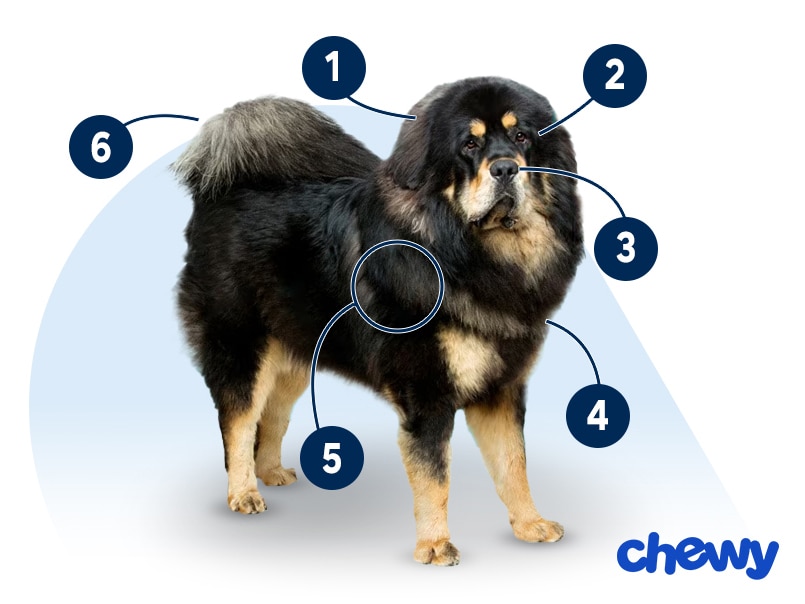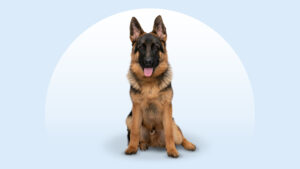Tibetan Mastiff
Updated December 15, 2025
Tibetan Mastiff
Updated December 15, 2025
Majestic and aloof from afar, the giant Tibetan Mastiff will show you what a loving, loyal pup they can be once you earn their trust. These gentle souls are devoted companions who need room to roam and do best with experienced pet parents.
Brainy, Introverted, Loyal
70–150 pounds
24–28 inches
10–12 years
Blue Gray, Brown and Tan, Red Gold Sable, Blue Gray and Tan, Black, Black and Tan, Brown, Red Gold
We’re not saying that if you ran into a Tibetan Mastiff in the woods that you’d definitely mistake them for a four-legged Sasquatch, but it’s possible. At their largest, they can be 150 pounds or more, and they have floofy, shaggy mane that would make a lion jealous.
But they also have a loyalty that’s as heartwarming as they are massive. If you give them lots of outdoor space and mentally stimulating tasks, they’ll be a true-blue friend.
Tibetan Mastiff Characteristics
Tibetan Mastiff Appearance
A Tibetan Mastiff’s fluffy fur gives them a bearlike appearance, and their thick mane lends a lion-esque air to their noble nature. Their expressive eyes are wise and alert. Hovering around 28 inches tall, even the Tibetan Mastiff’s height is impressive.

- Ears
Tibetan Mastiff ears are medium-sized, V-shaped, and high on the head. They droop forward when relaxed and stand at attention when your pup is alert.
- Eyes
Tibetan Mastiffs have watchful brown eyes, rimmed in black or dark gray. They’re almond-shaped and deep-set.
- Nose
Their nose is broad and can be black, dark gray, or dark brown, depending on the coloring of the coat.
- Coat Length
Tibetan Mastiffs are double-coated with a thick topcoat of long, coarse, and straight hair. The hair is thicker on the neck and shoulders, especially on males, giving them a lovely mane.
- Coat Color
Tibetan Mastiff colors include black, brown, blue gray, tan, and red gold.
- Tail
The Tibetan Mastiff tail is covered with a thick plume of feathered hair. It's usually carried high and curves over the back.
Tibetan Mastiff Temperament
Tibetan Mastiffs are introverts. They’re exceptionally loyal and adoring of their person (or family), but they tend to be wary of (or just completely ignore) strangers. They’ll probably think of you as their equal instead of as their pet parent, but they’re so smart and independent, they’re not exactly wrong.
Like all dogs, Tibetan Mastiffs require proper socialization from the time they’re a puppy (or as early as possible, if you adopt them when they’re older). With safe and supervised exposure to different people, pets, and situations, they’ll be more adaptable.
Tibetan Mastiff puppies can be taught to get along well with children and other pets when raised with them. But as adults, they may be less accepting of new dogs or other people’s children, even with socialization.
Because their sheer size, it’s a good idea to supervise all Tibetans around young children, cats, or small dogs. Teach all children how to interact gently and respectfully with dogs.
These dogs typically won’t love agility trials or anything else where speed comes into play. They’re happiest when they have their own little world to look after—give them a yard with room to roam and their own little paradise to “supervise,” and they’ll be thrilled.
How to Care for a Tibetan Mastiff
Despite all their fur, the Tibetan Mastiff is not as high–maintenance as you might think. They don’t need a lot of grooming or exercise, but they do need work to keep them well-socialized and good-mannered.
Grooming
Training
Diet
Exercise
Environment
Tibetan Mastiff Health
The typical Tibetan Mastiff lifespan is 10–12 years, and they don’t tend to have a lot of health issues. Here are some that may pop up:
- Bloat and gastric dilatation-volvulus (GDV): Tibetan Mastiffs, like many large breeds, are prone to a life-threatening condition called bloat that occurs when the stomach becomes distended with air and/or food. Sometimes, the stomach twists and cuts off blood to organs in the abdomen—this is called gastric dilatation-volvulus. Go to the emergency vet immediately if you notice signs of bloat or GDV: a distended abdomen, dry heaving, pacing and restlessness, and excessive drooling.
- Eye issues: Tibetan Mastiffs are prone to both entropion, in which the eyelid folds inward, and ectropion, which causes the lower lid to fold outward. These conditions don’t usually affect vision, but they can cause irritation, discomfort, and (in severe cases) cornea damage.
- Hip and elbow dysplasia: Common in large breeds, dysplasia is where the joints don’t fit together properly, whether it’s the hip or elbow. Treatment may include weight management, joint supplements, pain medication, physical therapy, or surgery.
- Hypothyroidism: Hypothyroidism is an endocrine disorder where the thyroid gland does not produce enough thyroid hormone. Symptoms include weight gain, lethargy, and chronic ear and skin infections. Low thyroid is typically easily managed with daily lifelong medication.
Tibetan Mastiff History
Tibetan Mastiffs are an ancient breed from the mountains of Central Asia. But despite their ancient origins (records of large guardian dogs date back to 1100 B.C.E. China), very little is known about their history, according to the American Tibetan Mastiff Association.
What is known is that in 1800, an English ship captain’s travel memoirs mentioned “huge” guardian dogs at the monasteries in Tibet. The first such dog was brought to England in 1847 and presented to Queen Victoria as a gift. A few decades later, in 1873, the breed officially entered England’s new Kennel Club as the Tibetan Mastiff.
The following year, the Prince of Wales brought two more of them to England, where they were eventually a part of the Alexandra Palace Show.
The American Kennel Club didn’t recognize this breed until 2007. But nowadays, you’d be much likelier to find one of these pups in the U.S. than you would in Tibet.
Tibetan Mastiffs cost anywhere from $2,500 to $3,500. If you choose this route, pick a responsible breeder.
You can also consider Tibetan Mastiff adoption. Look into a organizations like Tibetan Mastiff Rescue, keep an eye out at your local shelter or rescue, or search Chewy’s database of adoptable dogs in your area.








